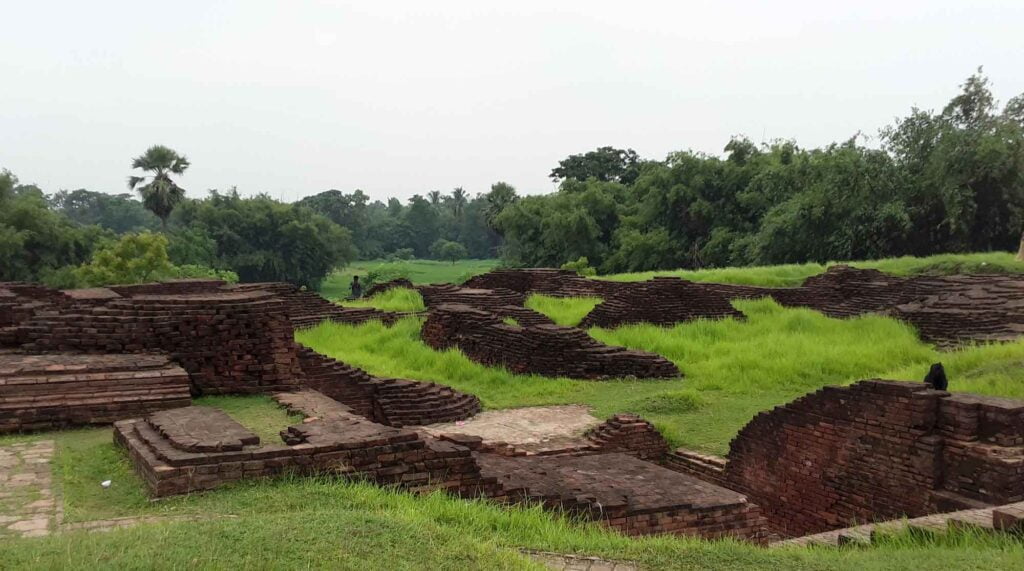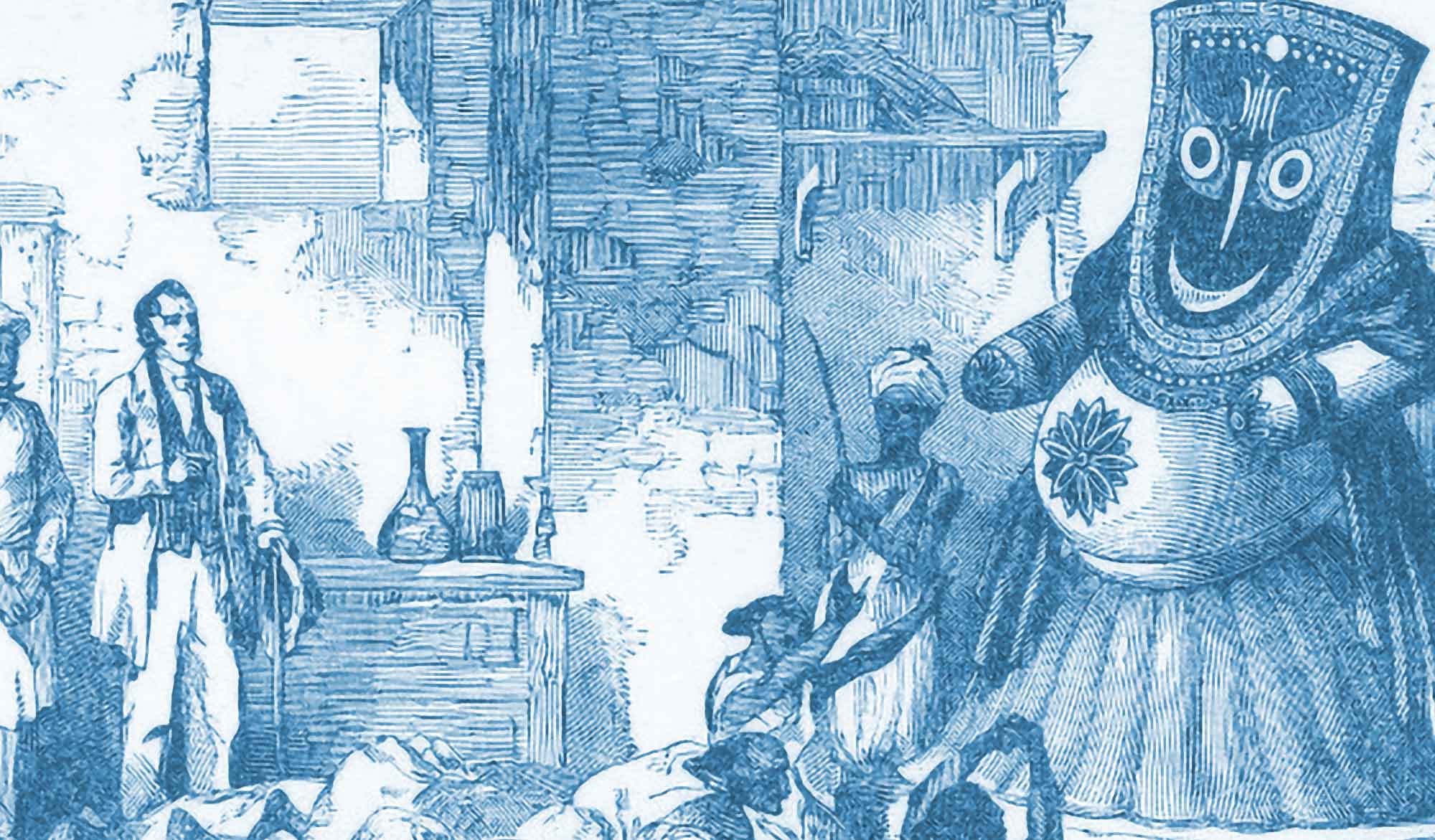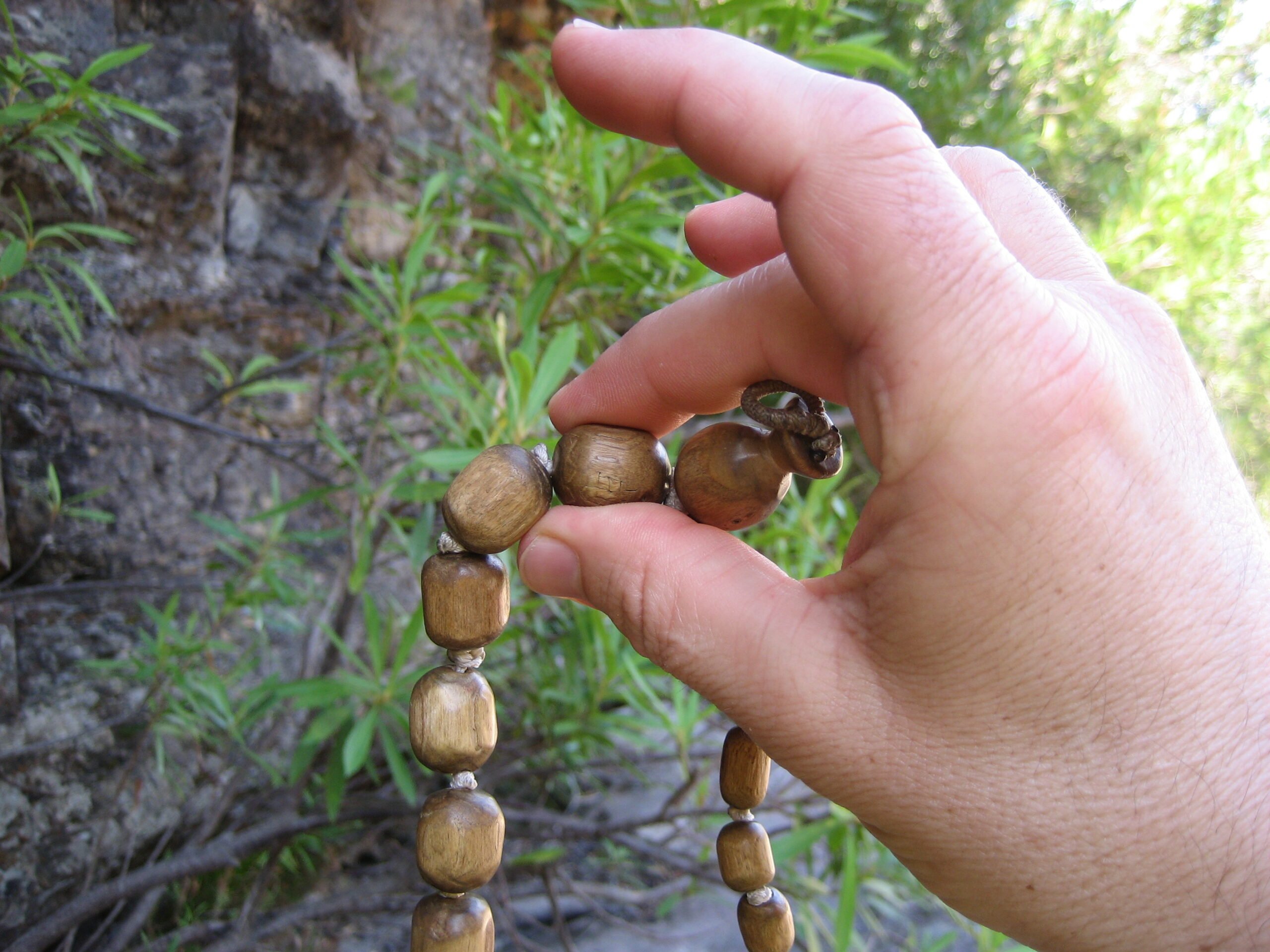Overview
Aparādha-Bhañjana Pāṭa Kuliyā Kothāya (Where is Kuliyā Aparādha-Bhañjana Pāṭa?) was first published in Sajjana Toṣaṇī, Vol.7 issue 2 in 1895. Herein, Bhaktivinoda Ṭhākura discusses the significance of the village of Kuliyā and establishes its true whereabouts.
(translated by Swami B.V. Giri)
Someone’s question has come to our hands. The questioner is a wise Vaiṣṇava. We will therefore proceed to answer this question carefully.
Presently, in many places in Bengal there are various villages in Bengal named Kuliyā. The Kuliyā we have been specifically asked about is a place unrivalled in the whole world. Why does history speak with special regard to that Kuliyā? The name of that Kuliyā is Śrīpāṭa Kuliyā. Śrīmad Gaurāṅga Prabhu, the avatāra who has come to deliver us in the age of Kali, resided in this place for seven days, chastised a great offender named Cāpāla Gopāla, and freed a scholar of Śrī Navadvīpa from his offences. Here, a resident, who lived near Maheśvara Viśārada’s dam, named Devānanda, who was a paṇḍita that recited the Bhāgavata, was purified of his offences to the devotees. At this place, a paṇḍita who was expert in Tantra named Kṛṣṇānanda had contracted a great disease due to Vaiṣṇava aparādha, and was mercifully delivered by Śrīman Mahāprabhu from his offence and from the disease. What better way could there be to decide where the holy town of Kuliyā is, other than deliberating upon the books written by paṇḍitas who were the contemporaries of Śrīman Mahāprabhu?
A few years ago, in a small village three miles east of Kumārahaṭṭa, a festival known as the Kuliyā-pāṭera Melā was established. Many people from Calcutta and other places come to this festival every year during the month of Pauṣa. For this reason when we mention the name of Kuliyā in front of common people, they understand it to be this village of Kuliyā. Actually, Kuliyā is called Aparādha Bhañjanera Pāṭa (where the Lord forgave offences) or Devānandera Pāṭa (the place of Devānanda) and is mentioned in Śrī Caitanya-bhāgavata, Śrī Caitanya-caritāmṛta, Śrī Caitanya-maṅgala, Śrī Caitanya-candrodaya-nāṭaka, Śrī Caitanya-carita-mahākāvya, and Prema Dāsa Bābājī’s commentary on the Candrodaya. This Kuliyā must be present within the sixteen krośas (thirty-two-mile) radius of Śrī Navadvīpa. It is said in Chapter Three of the Antya-khaṇḍa of Śrī Caitanya-bhāgavata:
kuliyā-nagara āilena nyāsi-maṇi
sei kṣaṇe sarva-dike haila mahā-dhvani
sabe gaṅgā-madhye nadīyāya kuliyāya
śuni’ mātra sarva-loka mahānande dhāya
vācaspati-grāmete yateka loka chila
tāra koṭi koṭi guṇe sakala bāḍila
(“Immediately, in all directions, a great sound was heard – ‘That crest-jewel of sannyāsīs has gone to Kuliyā.’ All that was in-between Nadīyā and Kuliyā was the Gaṅgā. Upon hearing this, everyone ran there in great bliss. The number of people coming from the village of Vācaspati increased millions of times.” – Caitanya-bhāgavata, Antya-khaṇḍa 3.379-381)
kṣaṇeke āilā mahāśaya vācaspati
(“After a while Vācaspati Mahāśaya came there.”- Caitanya-bhāgavata, Antya-khaṇḍa 3.394)
kuliyāra prakāśe yateka pāpī chila
uttama madhyama nīca sabe pāra haila
(“Manifesting in Kuliyā, He delivered everyone who was wicked – those who were extremely wicked, moderately wicked, and slightly wicked.”- Caitanya-bhāgavata, Antya-khaṇḍa 3.438)
henai samaye eka āsiyā brāhmaṇa
dṛḍha kari dharilena prabhura caraṇa
(“At that time, a brāhmaṇa came there and firmly grasped the feet of the Lord.”- Caitanya-bhāgavata, Antya-khaṇḍa 3.442)
kali-yuge kisera vaiṣṇava ki kīrtana
ei mata aneka nindinu anukṣaṇa
(“I would constantly think offensively, ‘In Kali-yuga, who is a Vaiṣṇava in Kali-yuga? What is this kīrtana?’”- Caitanya-bhāgavata, Antya-khaṇḍa 3.445)
saṁsāra-uddhāra-siṁha tomāra pratāpa
bala mora ki-rūpe khaṇḍaye sei pāpa
(“’To deliver the world, You are as strong as a lion. Tell me how I can remove such terrible reactions.’”- Caitanya-bhāgavata, Antya-khaṇḍa 3.447)
viprere karite prabhu tattva-upadeśa
kṣaṇeke paṇḍita devānandera praveśa
(“At the moment when the Lord was giving philosophical instructions to the brāhmaṇa, Devānanda Paṇḍita entered.”- Caitanya-bhāgavata, Antya-khaṇḍa 3.464)
pūrve tāna yata kichu chila aparādha
sakala kṣamiyā prabhu karilā prasāda
(“The Lord excused all of his previous offences and awarded His mercy to him.”- Caitanya-bhāgavata, Antya-khaṇḍa 3.492)
kuliyā-grāmete āsi śrī-kṛṣṇa-caitanya
hena nāhi yāre prabhu nā karilā dhanya
(“After Śrī Kṛṣṇa Caitanya came to the village of Kuliyā, the Lord did not neglect anyone, but made them most fortunate.”- Caitanya-bhāgavata, Antya-khaṇḍa 3.541)
Elsewhere in the text, Nityānanda Prabhu’s stay in Navadvīpa is described:
khānacauḍā baḍagāchi āra dogāchiyā
gaṅgāra opāra kabhu yāyena kuliyā
(“He went to Khānacauḍā, Baḍagāchi and Dogāchiyā, and sometimes He went to Kuliyā, on the other side of the Gaṅgā.” – Caitanya-bhāgavata, Antya-khaṇḍa 5.709)
Chapter One of the Madhya-khaṇḍa of Śrī Caitanya-caritāmṛta states:
kuliyā-grāme kaila devānandere prasāda
gopāla-viprere kṣamāila śrīvāsāparādha
pāṣaṇḍī nindaka āsi paḍilā caraṇe
aparādha kṣami tāre dila kṛṣṇa-preme
(“In the village of Kuliyā, He gave His mercy to Devānanda and He forgave the brāhmaṇa Gopāla for his offences to Śrīvasa. When that offensive atheist came and fell at His feet, He forgave his offences and awarded him with kṛṣṇa-prema.”- Caitanya-caritāmṛta, Madhya-līlā 1.154)
Śrī Kaviraja Gosvāmī did not elaborate upon Mahāprabhu’s arrival at Kuliyā. Because of this, it is not possible to understand the location of Kuliyā from his descriptions without proper awareness. In Chapter Sixteen of the Madhya-khaṇḍa, he wrote that from Kumārahaṭṭa He went to the house of Rāghava Paṇḍita in Pānihāṭi, and after giving darśana to Śrīvāsa, He went to the homes of Śivānanda Sena and Vāsudeva Datta in Kāñcanapallī, and then to the house of Vācaspati. We will show later that Vācaspati’s house is in Vidyānagara. Due to crowds of people at Vācaspati’s house, He went to the house of Mādhava Dāsa in the village of Kuliyā, and remained there for seven days. After that, He immediately went to Śāntipura, and from there to Rāmakeli. What he has written here is not a chronological order of the places. As he himself says:
śāntipure punaḥ kaila daśa-dina vāsa
vistāri’ varṇiyāchena vṛndāvana-dāsa
ataeva ihāṅ tāra nā kaila vistāra
punarakti haya grantha bāḍaye apāra
(“He remained at Śāntipura for ten days. This has been described in detail by Vṛndāvana Dāsa. Therefore I will not describe this elaborately, because it will be repetitive and the book will become voluminous.” – Caitanya-caritāmṛta, Madhya-līlā 16.211-212)
It is clear that Kavirāja Gosvāmī has not described all these topics in order. He relies upon the descriptions of Vṛndāvana Dāsa Ṭhākura.
It is written in Śrī Caitanya-maṅgala:
gaṅga snāna kari prabhu rāḍha-deśa diyā
krame krame uṭṭarilā nagara kuliyā
purvāśrama dekhibena sannyāsera dharma
navadvīpa āilā prabhu ei tāra marma
(“After the Lord took bath in the Gaṅgā in Rāḍha-deśa, He eventually went to the town of Kuliyā. The dharma of a sannyāsī is to visit the place of his previous āśrama. With this in mind, the Lord came to Navadvīpa.”- Caitanya-maṅgala. Śeṣa-khaṇḍa 3.2.1-3)
māyera vacane punaḥ gelā navadvīpa
bārakonā ghāṭa nija bāḍīra samīpa
(“Going to Navadvipa, He again spoke with His mother. From Bārakoṇā Ghāṭa He arrived at His home.” – Caitanya-maṅgala. Śeṣa-khaṇḍa 3. 230)
We can clearly see from this description that the village of Kuliyā is situated within Navadvīpa-maṇḍala. One need only cross the Gaṅgā and from there one can see the house in Māyāpura where the Lord lived in His previous āśrama. His house is situated near Bārakoṇā Ghāṭa. It is written in the Caitanya-candrodaya Nāṭaka:
tataḥ kumāra-haṭṭe śrīvāsa-paṇḍita-vāṭyām abhyāyayau
(“Then He went to Śrīvāsa Paṇḍita’s residence in Kumārahaṭṭa.”- Caitanya-candrodaya Nāṭaka 9.100)
tato’dvaita-vāṭīm abhyetya hari-dāsenābhivanditas tathaiva taraṇī-vartmanā navadvīpasya pāre kuliyā-nāma-grāme mādhava-dāsa-vāṭyām uttīrṇavān
(“Then He went to the home of Advaita, where Hari Dāsa offered obeisances to Him. Then crossing to the shore of Navadvīpa, He went to the village called Kuliyā. Then He went to the residence of Mādhava Dāsa.” – Caitanya-candrodaya Nāṭaka 9.104)
evaṁ sapta-dināni tatra sthitvā punas taṭa-vartmanaiva calitavān
(“Thus, having remained there for seven days, He again went to the shore of the Gaṅgā.”- Caitanya-candrodaya Nāṭaka 9.107)
It seems from the text that although Navadvīpa was on both sides, at that time there was a large village called Navadvīpa on the east side of the Ganges; and the village of Kuliyā where He went was on the west side.
In Śrī Caitanya-carita-kavya it is written in the Twentieth sarga that He stayed overnight at Śrī Rāma’s house, then went to the homes of Vāsudeva Datta and Śivānanda Sena in the village of Kāñcanpalli, passed through Śāntipura and went to some villages on the other side of Navadvīpa.
anyedyuḥ sa śrī-navadvīpa-bhūmeḥ pāre gaṅgaṁ paścime kvāpi deśe
śrīmān sarva-prāṇināṁ tat tad aṅgair netrānandaṁ samyag-āgatya tene
(“The next day, He went to the land of Śrī Navadvīpa on the western side of the Gaṅgā. The eyes of all felt great bliss everyone upon seeing the Lord who is the life of all, arriving.” Caitanya-carita-kavya 20.26)
It is clear that Navadvīpa is on the east side of the Gaṅgā and the town of Kuliyā is on the west side of the Gaṅgā. Being immediately on the Gaṅgā, the town of Kuliyā cannot be more than one krośa (approx. 1.8 miles) from the town of Navadvīpa.
Reading the descriptions of all these writers surely means that the Kuliyā which is seen to be three-miles east of Kācaḍārāpāḍā can in no way be the Aparādha Bhañjanera Pāṭa of Devānanda etc. Kuliyā is located about one krośa on the west bank of the Gaṅgā in old Navadvīpa. Furthermore, the village of Sāta-Kuliyā is also situated on the eastern side of the Gaṅgā about three krośas (7- 8 miles) away from the old Navadvīpa. This village is also not Aparādha Bhañjanera Pāṭa. There are no rumours that this (Sāta-Kuliyā) was ever a city, and that important people had their houses there.
At this point we have to decide which village near the old Navadvīpa on the west bank of the Gaṅgā is called Kuliyā. However, due to the change in the course of the Gaṅgā, much of that town of Kuliyā may have been ruined. Yet there is no doubt that some part of it, as well as hearsay may identify it.
We can see that the home of Vidyā Vācaspati was not very far from Kuliyā; that is because as soon as Vācaspati heard that Mahāprabhu had come to the village of Kuliyā, he reached there immediately and did not have to cross to go to Kuliyā. Therefore, Kuliyā and Vidyānagara must be understood to be situated on the same bank, and are one or two miles apart. Now see! Where is the house of Vidyā Vācaspati?
In the Caitanya-bhāgavata it says:
sārvabhauma bhrātā vidyā-vācaspati nāma
(“Vidyā Vācaspati was the name of Sārvabhauma’s brother.” – Caitanya-bhāgavata, Antya-khaṇḍa 3.272)
In Chapter 21 of the Madhya-khaṇḍa of Caitanya-bhāgavata, it is said:
hena-mate navadvīpe prabhu viśvambhara
vihare saṁhati-nityānanda-gadādhara
eka-dina prabhu kare nagara-bhramaṇa
cāri-dike yata āpta-bhāgavata-gaṇa
sārvabhauma-pitā viśārada maheśvara
tāṅhāra jāṅghāle gelā prabhu viśvambhara
seikhāne devānanda paṇḍitera vāsa
parama suśānta vipra mokṣa-abhilāṣa
(“In this way, Lord Viśvambhara sported in Navadvīpa in the company of Nityānanda and Gadādhara. One day the Lord was wandering around the town surrounded on all sides by His confidential devotees. He went near the dam of Viśārada Maheśvara, the father of Sārvabhauma. At that place also was the residence of Devānanda Paṇḍita, who was an extremely peaceful brāhmaṇa who desired mokṣa.” – Caitanya-bhāgavata, Madhya-khaṇḍa 21.4-7)
From this description we know that Maheśvara Viśārada was the father of Sārvabhauma and Vidyā Vācaspati. Near to the dam on which the home and school of Maheśvara Viśārada was situated, was the residence and Bhāgavata school of Devānanda Paṇḍita. At that time, Gaṅgā Devī was near Mahātpura or Mātāpura, and from there she touched villages such as Māugācchi, Jānnangara etc. and keeping Viśārada’s dam on her western bank, she ran eastwards for a short distance, passing through Gaṅgānagara, then from Śrī Māyāpura, then south-westwards, on the shores of Kuliyā, flowing south through the village of Kuliyā.
Long before the advent of Śrīman Mahāprabhu, the Gaṅgā flowed by the western side of Kuliyā towards the south. At the time of Maheśvara Viśārada, this route of the Gaṅgā dried up. Although it dried up, even today that land is still filled with water, mud, kuśa, thorns etc. Because it was not fit to live there in the rainy season, a few brāhmaṇa-paṇḍitas built a small village called Vidyānagara by building a dam across the Dewan Bazaar of the then Navadvīpa. To get to Viśārada’s dam from old Navadvīpa, one had to walk on the bank of the Gaṅgā via Gaṅgānagara, Ātapapura, and the ghāta at Dewan Bazaar. After crossing the ghāṭa, one had to walk through thorn bushes in order to reach the dam. There is plenty of evidence to prove that Vidyā Vācaspati’s house was in Vidyānagara. That is because, to go to Viśārada’s dam from Navadvīpa, everyone had to go through forests, brush, thorns and woods. However, this was not the case in getting to Kuliyā. To go to Kuliyā from old Navadvīpa, one only had to cross the Gaṅgā. Although previously the village of Vidyānagara was known as Viśāradera Jāṅgāla (Viśārada’s dam) still we assume that it later became known as Vidyānagara due to the glories of Vidyā Vācaspati. Now there is a place known as the village of Kuliyā situated on the western bank of the Gaṅgā. Some people refer to this place as Kolera Gañja. Many parts of the village have been destroyed, and because of the change in the Gaṅgā’s course, the western part of old Navadvīpa has become one with Kuliyā, and the major part of Kuliyā has merged with Navadvīpa. We have many more things to say in relation to this change, which we will discuss later. There were two villages, Kuliyā and Pāhāḍapura, alongside each other. That village of Kuliyā is now Navadvīpa. And we do not hesitate to state that this Navadvīpa is the place of Kuliyā, the place of Devānanda, and Aparādha Bhañjanera Pāṭa. As the main name of Navadvīpa extends to Kuliyā, it is not necessary to identify that place by those names.
Seeing that our article is expanding, we will end at this place today. In the future, we will support this subject with more specific evidence.













